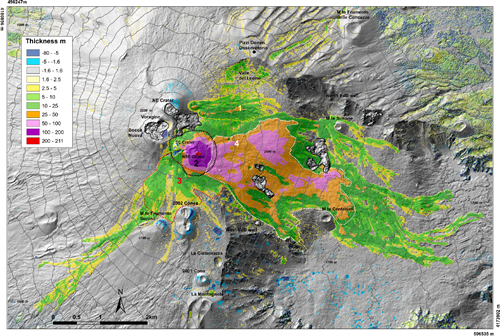Ten years of volcanic activity at Mt Etna: High-resolution mapping and accurate quantification of the morphological changes by Pleiades and Lidar data

Bisson M., C. Spinetti, D. Andronico, M. Palaseanu-Lovejoy, M. Fabrizia Buongiorno, O. Alexandrov, T. Cecere.
International Journal of Applied Earth Observations and Geoinformation, 102, https://doi.org/10.1016/j.jag.2021.102369
Abstract
The topography of Mt. Etna, Italy, is subjected to continuous modifications depending on intensity and magnitude of eruptions that frequently occur at the volcano summit and flanks. In order to make high-resolution maps of morphological changes and accurately calculate the overall volume of the erupted products (e.g., lava flows, tephra fall out, scoriae cones) in ten years, we have compared the altimetry models of Mt. Etna derived from 2005 Airborne Laser Scanning data and 2015 Pleiades stereo satellite imagery. Both models cover a common area of 400 km2 with spatial resolution of 2 m and comparable vertical accuracy (RMSE < 0.8 m). The results show that the area most affected by the erupted products is the mid-upper portion of the volcano with an altitude ranging from 1300 m to more than 3300 m a.s.l., value reached at the summit of the North East crater. In particular, this portion changes dramatically in the eastern sector due to the birth and growth of the New South-East Crater, the invasion of dozens of lava flows in the Valle del Bove, and the formation of the 2014 scoriae cones and lava field at the base of the North-East Crater. The total volume of products erupted in the investigated period results in 284.3±15.8 x 106 m3 with a yearly average volume of 28.4 x 106 m3/y comparable with the previous decades. In addition, the products emitted by the 2014 sub-terminal eruption are mapped and quantified including, for the first time, the volume of the 2014 scoriae cones generated on the eastern flank of North-East Crater This study demonstrates how a rigorous comparison between digital elevation models derived from different remote sensing techniques produce high accurate mapping and quantifications of morphological changes applicable for worldwide active volcanoes. This allows to quantify volumes and areas of erupted products reducing the error estimations, a crucial point to provide precise data often used as key parameters for many volcanic hazard studies.



Devi effettuare l'accesso per postare un commento.